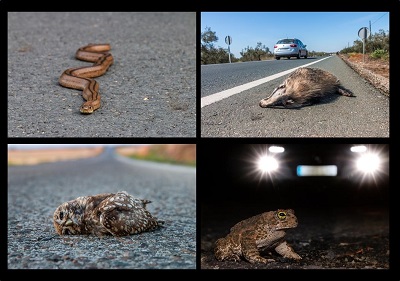The project SAFE – Stop Atropellos de Fauna en España, a citizen science initiative to analyse the mortality of fauna on Spanish roads, has been officially presented this morning. The aim of this project is to bring to light for the first time the numbers for the mortality of vertebrate species on Spanish roads, which is a serious problem for some threatened species such as the Iberian lynx and for the road safety.
The event, a videoconference open to public, had the participation of representatives of the Ministry for the Ecological Transition and the Demographic Challenge (MITECO), promoter of the project; the Doñana Biological Station (EBD-CSIC), scientific head of the project; and three of the main Spanish scientific societies, the Spanish Herpetological Association (AHE), the Spanish Ornithological Society (BIO/Birdlife) and the Spanish Society for the Conservation and Study of Mammals (SECEM), which will lead the volunteer mobilization.
SAFE will make use of the citizen science to collect data. The volunteers involved in the project will choose an itinerary and will do it by bicycle, on foot or by car at least once a month for a year, recording every run over animal they see on mobile applications or manually. Volunteers can register through one of the three scientific associations, through any other or individually. Project SAFE's success will only be achieved thanks to the voluntary involvement of many people. To facilitate this participation, different tutorials have been presented (available on the EBD-CSIC YouTube channel) that will serve to make easier these tasks.
The animal roadkill is one of the most evident impacts that transport routes produce in ecosystems. However, there is not much information on the fauna mortality generated by road traffic, and what is known, is dispersed in different sources. The collection of data on these fixed itineraries, travelled repeatedly and distributed throughout the Spanish territory, will provide a unique opportunity to quantify this problem, evaluate which species are m ost affected by this problem and find out what factors (what types of habitats or pathways, what times of the year) influence whether more or fewer animals are run over. In addition, the aim of the initiative is that volunteers can keep visiting their itineraries beyond the end of the project and new ones can join with additional routes, giving rise to a network to monitor the animal roadkill.
Presentation of the project (Spanish)
https://www.youtube.com/watch?v=outS_-jk_zY
MITECO Working Group on Habitat Fragmentation Caused by Transport Infrastructures https://www.miteco.gob.es/en/biodiversidad/temas/ecosistemas-y-conectividad/conectividad-fragmentacion-de-habitats-y-restauracion/fragm_habitats_causa_transp.aspx
Apps tutorials (Spanish):
- Signup in Observation.org https://www.youtube.com/watch?v=I4x7BzlBNwQ
- Make your itinerary https://www.youtube.com/watch?v=XlqN4a4DeJg
- Link your data to SAFE https://www.youtube.com/watch?v=vj2XPLyB53U


